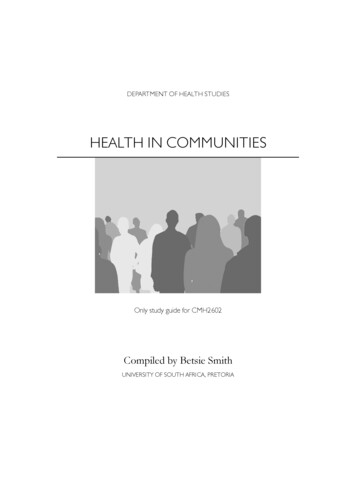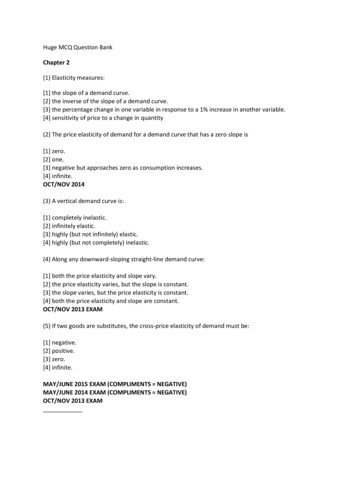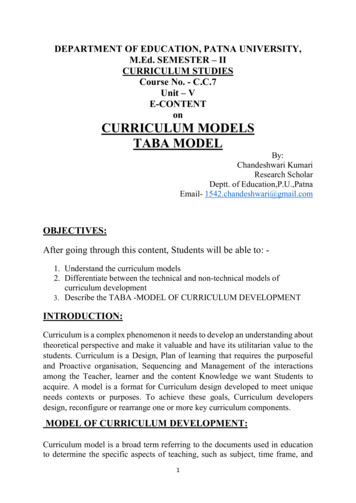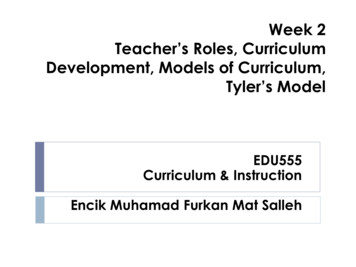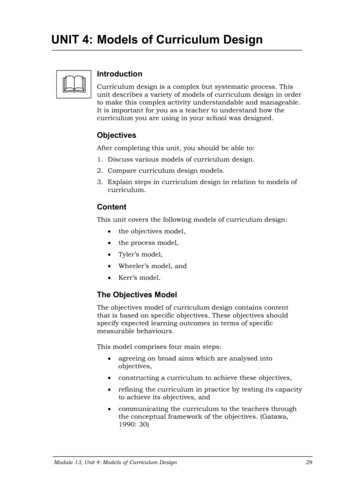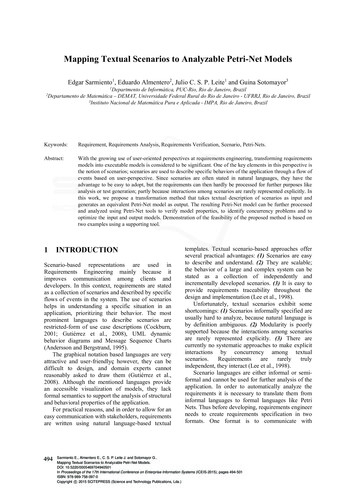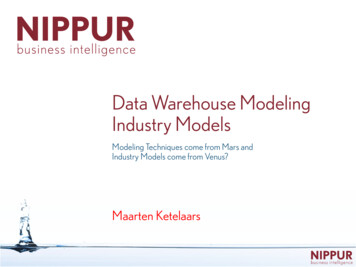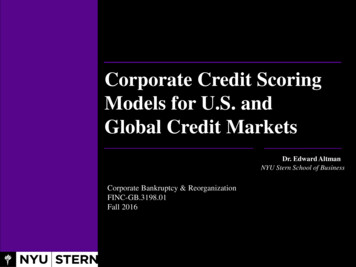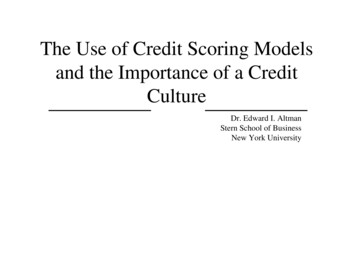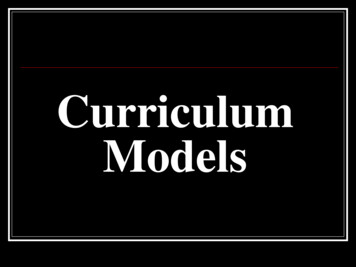
Transcription
CurriculumModels
A Definition of Curriculum(Daniel Tanner, 1980)“The planned and guided learningexperiences and intended learning outcomes,formulated through the systematicreconstruction of knowledge and experiences,under the auspices of the school, for thelearners’ continuous and willful growth inpersonal social competence.”
SUBJECT-CENTEREDDesign Model
Subject-Centered CurriculumThis model focuses on the content ofthe curriculum.The subject centered designcorresponds mostly to the textbookwritten for the specific subject.
Subject-Centered CurriculumThe subject-centered curriculum can befocused on traditional areas in the traditional disciplinesinterdisciplinary topics that touch on a widevariety of fieldson processes such as problem solvingon the goal of teaching students to be criticalconsumers of information.
Subject-Centered CurriculumA curriculum can also be organized around asubject center by focusing on certainprocesses, strategies, or life-skills, such asproblem solving, decision making, orteamwork.
Subject-Centered CurriculumIn the Philippines, our curricula inany level is also divided in differentsubjects or courses. Most of theschools using this kind of structureaim for excellence in the subjectmatter content.
Examples of Subject-centered curriculum:1. Subject DesignThe drawback of his design is that sometimes learning isso compartmentalized.It stresses so much the content that it forgets aboutstudents’ natural tendencies, interest and experiences.2. Discipline DesignDiscipline refers to specific knowledge and through a methodwhich the scholars use to study a specific content of theirfields.
Examples of subject-centered curriculum:3. Correlation DesignThis comes from a core, correlated curriculum design thatlinks separate subject designs in order to reducefragmentation. Subjects are related to one another but eachsubject a maintains its identify.4. Broad field design/interdisciplinaryThis design was made to prevent the compartmentalizationof subjects and integrate the contents that are related toeach other.
Examples of Subject-centered curriculum:Students in history should learn the subjectmatter like historians, students in biology shouldlearn how biologist learn, and so with studentsin mathematics should learn howmathematicians learn.The discipline design model of curriculum is oftenused in collegeDiscipline becomes the degree program.
Reflection: Let’s review the following: Basic Education Curriculum (BEC)Secondary Education Development Program(SEDP)College Algebra syllabusWhat curriculum design(s) do you find?Do your schools support the subject –centered curriculum?
Learner-Centered Curriculum centeredon certain aspects of the learnersthemselves. mayexplore the learner’s own life or familyhistory or local environment.
Learner-Centered Curriculum1. Child-centered design(John Dewey, Rouseau, Pestallozi and Froebel ) It is anchored on the needs and interests of the child. The learner is not considered as a passive individualbut as one who engages with his/her environment. Onelearns by doing. Learners interact with the teachers andthe environment.
Learner-Centered Curriculum2. Experience-Centered designExperiences of the learners become the starting point of thecurriculum.Thus the school environment is left open and free.Learners are made to choose from various activities that theteacher provides.The learners are empowered to shape their own learning fromthe different opportunities given by the teacher.
Learner-Centered Curriculum3. Humanistic design Abraham Maslow and Carl Rogers.MaslowThe development of self is the ultimate objective ofleaning. It stresses the whole person and theintegration of thinking, feeling and doing. It considersthe cognitive, affective and psychomotor domains tobe interconnected and must be addressed in thecurriculum. It stresses the development of positiveself-concept and interpersonal skills.
Advantages: It gives power to the learners: they areidentified as the experts in knowing whatthey need to know. The constructivist element of this approachhonors the social and cultural context of thelearner.
Advantages: It creates a direct link between in-classwork and learners' need for literacy outsidethe classroom.As a result, learners can more easily transfer new skillsto day-to-day use (Purcell-Gates, et al., 2001). Theimmediacy of this transfer of skills at home, at work, andin communities also encourages learner persistence.
Disadvantages: It often relies on the teacher's ability to create or selectmaterials appropriate to learners' expressed needs.This requires skill on the part of the teacher, as well astime and resources: at a minimum, texts brought in fromreal life, a wide pool of commercially available materialsfrom which to draw, and a reliable photocopier. Giventhe reality of teachers' professional preparation andworking conditions (Smith, et al., 2001), lack of skill,time and resources makes creating curriculum with thisapproach difficult.
Disadvantages: Teachers may also find it difficult to strikean acceptable balance among thecompeting needs and interests of students.
Alternative Methods for aLearner-Centered Curriculum(These are only suggestions for supplementing your style, not substituting for it) Individualized diagnosis and (some) course objectivesProgrammed learning sequencesMulti-sensory instructional activitiesStudent-designed creative activitiesSmall-group activities (in and out of class)Design competitive gamesDesign problem solving gamesFocus on team learning/peer teachingChange the seating configurationsLearning contractsOrganize structured drillsPaired activitiesDesign task cardsRole playRead aloudSit on the floor in a circleStandard lectureTeacher demonstrations
Alternative Methods for aLearner-Centered Curriculum(These are only suggestions for supplementing your style, not substituting for it) Go outside or meet in an alternate location Speedwriting Listserve, online forums Computer applications Socratic dialogue (question-answer-deeper question) Chunk knowledge and connect chunks to make “big picture” Multimedia presentations (film, CDs, audio-tapes, animated graphics) Student presentations (encourage multi-sensory supports) Cancel class and meet students individually Present multiple invention and discovery techniques (brainstorming, clustering, freewriting, idealetters, graph and object relationships, meditations, dreams, art, etc.) Split Page (key phrases on one side, commentary on other) Color code ideas in documents and lesson plans (already known, yet-to-learn, still negotiating) Reverse question (look at answers and solutions first; create a question that it answers next) Treat objective questions an essay questions
Reflection: Let’s review the following: Basic Education Curriculum (BEC)Secondary Education Development Program(SEDP)College Algebra syllabusWhat curriculum design(s) do you find?Do your schools support the learner –centered curriculum?
Problem-Centered CurriculumProblem-centered curriculum, or problembased learning, organizes subject matteraround a problem, real or hypothetical, thatneeds to be solved.
Problem-Centered CurriculumProblem-centered curriculum is inherentlyengaging and authentic, because thestudents have a real purpose to their inquiry - solving the problem.
Problem-Centered Curriculum Types of problems to be explored may include: Life situations involving real problems of practiceProblems that revolve around life at a givenschoolProblems selected from local issuesPhilosophical or moral problems
Problem-Centered Curriculum1.Life-situations designIt uses the past and present experiences of learners as a means toanalyze the basic areas of living.As a starting point, the pressing immediate problems of the society andthe student’s existing concerns are utilized.Based on Herbert Spencer’s curriculum writing, his emphases wereactivities that sustain life, enhance life, and in rearing children, maintainthe individual’s social and political relations and enhance leisure, tasksand feelings.The connection of subject matter to real situations increases therelevance of the curriculum.
Problem-Centered Curriculum2.Core designIt centers on general education and the problemsare based on common human activities.The central focus of the core design includescommon needs, problems, concerns, of thelearners.
Reflection: Let’s review the following: Basic Education Curriculum (BEC)Secondary Education Development Program(SEDP)College Algebra syllabusWhat curriculum design(s) do you find?Do your schools support the problem –centered curriculum?
Curriculum Development ModelsThese are based on a body of theory aboutteaching and learning.These are targeted to needs &characteristics of a particular group oflearners.Outline approaches, methods, & proceduresfor implementation.
Curriculum Development ModelsDeductive Models:1.Saylor, Alexander, and Lewis’s2.Tyler’sInductive Model:3. Taba’s model
Models of Curriculum DevelopmentThe Taba ModelTaba took what is known as a grass-roots approach tocurriculum development. She believed that thecurriculum should be designed by the teachers ratherthan handed down by higher authority. Further, shefelt that teachers should begin the process by creatingteaching-learning units for their students in theirschools rather initially in creating a general curriculumdesign.
Models of Curriculum DevelopmentThe Taba Modelan inductive approach to curriculum development,starting with specifics and building up to a generaldesign
The Taba ModelFive-Step Sequence.1. Producing pilot units - linking theory and practicea.) Diagnosis of Needsb.) Formulation of Objectivesc.) Selection of Contentd.) Organization of Contente.) Selection of Learning Experiencesf.) Organization of Learning Activitiesg.) Determination of what to evaluate and of the waysand means of doing ith.) Checking for Balance and Sequence
The Taba ModelFive-Step Sequence (cont.):1.2. Testing Experimental Units3. Revising and consolidating4. Developing a Framework5. Installing and disseminating new units.
Saylor, Alexander, and Lewis’s conception of the curriculumplanning process:GOALS & IONCURRICULUMEVALUATIONDecisions as todesign(s) made bythe responsiblecurriculum planninggroup(s) for aparticulareducational center.Various priordecisions bypoliticaland social agenciesmay limit thefinal design(s).(Instruction)Decisionsas to instructional modesmade by responsibleteacher(s).The curriculum planincludes alternativemodes with suggestionsas to resources,media, and organization,thus encouragingflexibility and morefreedomfor the teacher(s)and students.Decisions as to evaluativeprocedures for determininglearner progress made bythe responsibleteacher(s).Decisions as to evaluativeprocedures for evaluating thecurriculum.Plans are made by theresponsible planninggroup.Evaluative data become basesfor decision makingin further planning.
Models of Curriculum DevelopmentThe Saylor, Alexander, and Lewis ModelCurriculum: “a plan for providing sets of learningopportunities for persons to be educated.”Curriculum planners begin by specifying themajor educational goals and specific objectivesthey wish to be accomplished.
Models of Curriculum DevelopmentThe Tyler ModelThe best or one of the best known models forcurriculum development with special attention toplanning phases is Ralph W. Tyler’s in his classic littlebook, Basic Principles of Curriculum and Instruction.
The Tyler Model of Curriculum DesignThe nature and structure ofknowledge The needs of the society The needs of the learner
Tyler:Fundamental Questions in Developing Curriculum What educational purposes should the schoolseek to attain?What educational experiences can be providedthat are likely to attain these purposes?How can these educational experiences beeffectively organized?How can we determine whether and to whatextent these purposes are being attained?
Reflection: On what bases would you choose a modelfor curriculum development?Who should decide which model forcurriculum development to follow?Is the Tyler rationale a suitable basis forcurrent curriculum development?
Models of Curriculum Development The Taba Model Taba took what is known as a grass-roots approach to curriculum development. She believed that the curriculum should be designed by the teachers rather than handed down by higher authority. Further, she felt that teachers should begin the process by creating teaching-learning units for their students in their schools rather initially in creating .
